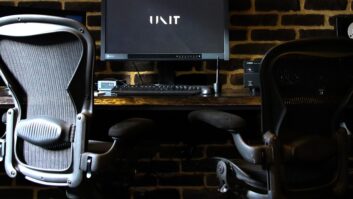The shift within the broadcasting industry, both culturally and technically, over the last year and a half cannot be underestimated. Working models that had previously been unthinkable, became the norm and teams quickly had to adjust to a reduction in both personal freedoms and interaction with colleagues.
The industry is now transitioning from emergency response mode, where the priority was business continuity, to more of a long-range planning mindset. Previously the primary focus for broadcast organisations had been to maintain consistent output of content and match established workflows as closely as possible. However, in recent months things are changing. Teams have been operating from home for long enough now, that some of the key challenges of remote working are becoming more apparent.
Siloed Teams
No two individual experiences of working from home have been comparable during the pandemic. From the obvious differences, such as in working in a studio flat, to working in a house with a spacious garden, through to varying childcare responsibilities. Personal circumstances can impact both performance and motivation. At the onset of Covid, there were several articles which commented that 100 per cent home working seemed to increase productivity. This is unsurprising really, as commuting time disappeared, and staff were able to work more flexibly around other commitments.
That said, teams are also working significantly more, as Forbes highlights, “Employees may report they’re more productive, but we also know they’re working more hours. So, it’s not that they’re actually packing more work into the same envelope.” This extensive grind is inevitably leading to Covid burn-out for employees, which is compounded by the lack of interaction with colleagues and can lead to feelings of isolation. Forbes also notes that, “While some virtual work has its virtues, people just cannot be as effective when they’re collaborating on a remote basis for all their tasks, all the time.”
After more than a year of remote working, research from Microsoft published in the Harvard Business Review, offers some interesting insights into working relationships. It explains that teams are becoming much more siloed, “In particular, connections with people outside our immediate teams has shrunk dramatically, leading to fewer places to connect around innovative ideas and fewer opportunities to build social capital.”
The move to Hybrid
As the negatives of 100 per cent remote working become more apparent, most sectors seem to be looking ahead to a blended working environment post-pandemic. By balancing the two approaches it seems that we can all experience the best of both worlds. The broadcasting industry needs to prepare for a 50/50 approach. But how can teams work together effectively when some staff will be in the office, and some will be working from home?
Classically edit stations have been fixed positions in-house or within a post production facility, but with new infrastructure coming to the fore traditional editing models are changing. As organisations look to reduce physical office space, it may not even be possible for all staff to be in the office at the same time. Companies will need to think creatively to build a sense of unity within their teams, wherever they are based. To ensure that a hybrid approach succeeds, the total workflow experience must be consistent, and technology needs to facilitate this.
This raises questions around whether the industry is technically prepared for the shift to hybrid and the outcomes of the changes that have been implemented so far. As is always the case, a lot of parallels can be drawn between the technical and human impact on workflows. The disaggregation of both people and systems can only work as a short-term solution, eventually predictability and visibility need to return. But this cannot mean a complete loss of autonomy for broadcasting teams.
Speaking the same language
One of the key stumbling blocks when building long-term hybrid workflows is a lack of consistency between different systems. In many cases the current commentary on the ease of working from home, as well as the systems that enable this, are centred around corporate IT. The uptake of video conferencing, workload scheduling and collaboration tools has of course been widespread, but this doesn’t always translate seamlessly into the broadcasting environment.
For many large-scale broadcasters there is a world of difference in the way that the broadcast systems and the corporate IT systems operate. To a certain extent, most staff with a laptop were already set up with the basics for remote work well before the pandemic began. For editors, who were involved in complex workflows and managed huge file sizes on a daily basis, it was not so simple.
As well as the increased complexity, managing the way that the two systems link to each other is another hurdle when creating a seamlessly integrated working environment. To handle the cross-over between the two systems and develop processes that will support long-term hybrid working models, clearing the information security bar is crucial. The procedures used to protect electronic data from unauthorised access or use, need to speak the same language. Broadcast systems could be asking for throughput protocol support and applications but those requests might be something that the corporate systems just don’t understand.
Another consideration is that historically, broadcast systems were secured by the building they were located in. During the outbreak of the pandemic, information security exceptions became a commonplace way of broadcasters responding to the crisis. Now it is vital to go back and review the strategic decisions that were made to keep teams operational. This can be challenging when moving to a hybrid model, with both on-premises and remote access is needed. The volume of security considerations and due diligence required increases significantly. Delivering systems integration goes beyond accessibility, solutions must be secure too.
Building a blended working environment
In order to deliver long-term sustainability, it’s important to consider that infrastructure within organisations needed to adapt very quickly to accommodate changes in working processes. As a result, there is inevitably a lot of sprawl within larger broadcasters, not only from the perspective of teams being siloed but also in the way that they are storing and sharing data.
Media and broadcast companies now need to consider both human and technical silos and work to integrate both their systems and their staff. In some cases, systems within different broadcasters can be identical, but the outcomes will differ based on how organisations engage the end users. Broadcasters cannot adopt a “build it and they will come” mentality, because quite often this leads to staff sidestepping processes and creating their own. By focusing on user integration and education, broadcasters can help staff connect on projects and adopt new workflows, but they can also learn from those users to ensure infrastructure evolves over time. The use of next-gen solutions is never abstract and by aggregating technology, broadcasters can also aggregate people. To build stronger, more resilient teams for the hybrid shift that’s on the horizon.







